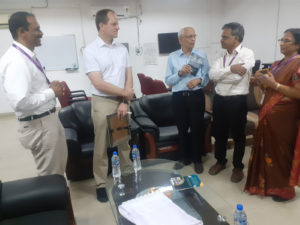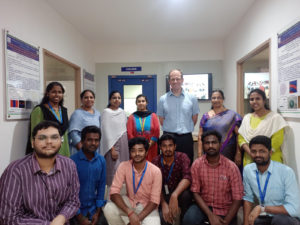 Over the course of several years, mechanical engineering professor and department chair Bruce Gale has been collaborating with professor L Sujatha, from Rajalakshmi Engineering College in India, to help them establish a microfluidics lab using microfabrication and silicon processing. That collaboration led to a Fulbright Specialist Award for Gale to spend two weeks in India continuing to help develop their microfluidics research program with a series of lectures and discussions and hands on feedback.
Over the course of several years, mechanical engineering professor and department chair Bruce Gale has been collaborating with professor L Sujatha, from Rajalakshmi Engineering College in India, to help them establish a microfluidics lab using microfabrication and silicon processing. That collaboration led to a Fulbright Specialist Award for Gale to spend two weeks in India continuing to help develop their microfluidics research program with a series of lectures and discussions and hands on feedback.
This collaboration started over email when Sujatha reached out to Gale. They had started building out their microfluidics lab, found some of his papers, and tried to implement them. Gale helped them work through some issues, as well as helping answer questions on manufacturing processes. Eventually, they put in for a Fulbright to bring Gale out to further the collaboration.
As with so many things, the initial plans were delayed due to the pandemic. Finally, in March Gale was able to travel to India along with his wife and three of his children. Over the course of his visit, Gale delivered 32 lectures. Each of the 8 main working days started with a professional development lecture for the local faculty on topics like how to write a paper, mentoring, collaboration, getting students accepted to US universities, and more. The second and third lectures each day were focused on microfluidics and based on the microfluidics course that Gale offers at the U. After lunch each day, Gale gave lectures based on his research in microfluidics. In addition to the time spent at the engineering college, Gale also spent a day at the sister institution Rajalakshmi Institute of Technology.
 “It was great getting to interact with the students and faculty,” said Bruce. “Outside of the lectures, I had the opportunity to work one-on-one with both faculty and students to help solve problems related to research projects on which they were working, helped them understand how their work fits into the wider world of microfluidics, or shared feedback on proposals for new medical devices. Everyone treated me so well, my wife worried it would go to my head.”
“It was great getting to interact with the students and faculty,” said Bruce. “Outside of the lectures, I had the opportunity to work one-on-one with both faculty and students to help solve problems related to research projects on which they were working, helped them understand how their work fits into the wider world of microfluidics, or shared feedback on proposals for new medical devices. Everyone treated me so well, my wife worried it would go to my head.”
Gale is also looking forward to future collaborations. The group in India is more focused on simulations, whereas Gale’s lab does a lot more actual design and manufacturing. This opens opportunities to share resources to widen the impact of research, as well as doing work at the U that they don’t have the tools for in India. It’s also another great avenue to recruit good students from India for a graduate degree at the U.
“Everyone was super friendly,” said Gale. “Traffic was absolutely crazy, but we never had any issues and I really enjoyed the opportunity to see the sights in addition to working with students and faculty. I’m looking forward to continuing to grow this collaboration and finding future opportunities to visit as well as bringing students to the U.”
You can learn more about professor Gale’s work through the State of Utah Center of Excellence for Biomedical Microfluidics: https://mems.utah.edu/